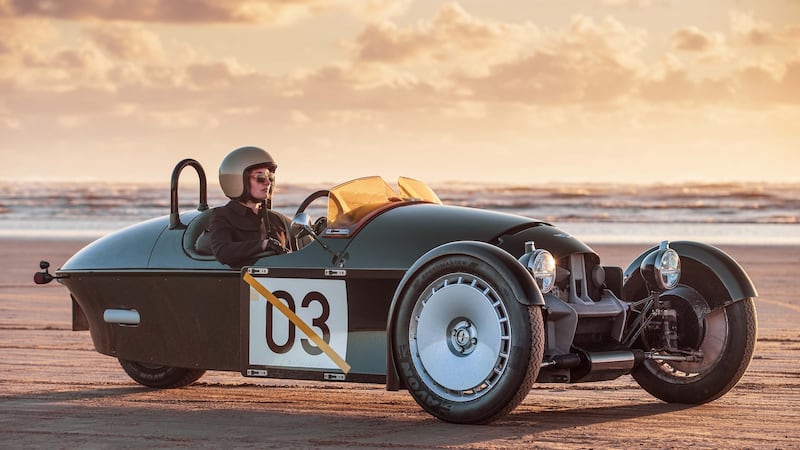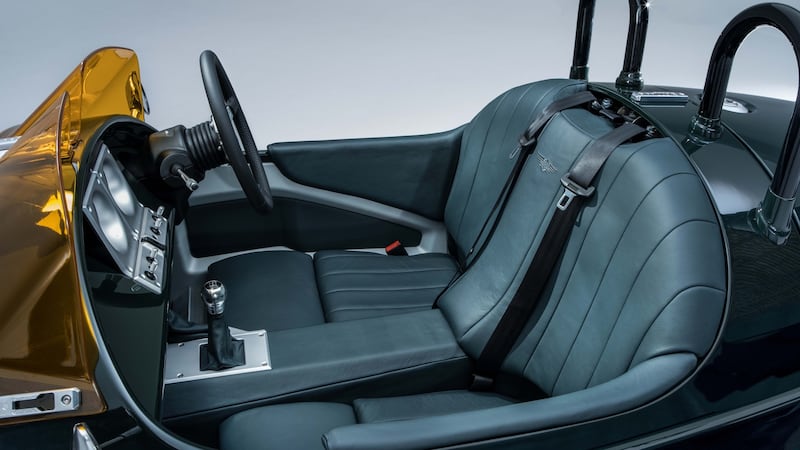There's a lot you can spend €78,000 on. A lifetime's worth of holidays? Education for your child and several of their friends? A one-bed apartment in Letterkenny (seriously, we checked). Or how about an upturned bathtub on three wheels, with the engine from a Fiesta? Yes, that's much more like it. . .
If that sounds like a lot of money for what we've just described, maybe that's because we omitted one crucial word – Morgan. The famed maker of hand-built sports cars actually started out by building cars with only three wheels. Why? Because, under some arcane law in the United Kingdom at the time, such vehicles were classified as motorbikes and so were cheaper in tax terms. Morgan started making cars in 1910, but didn't make one with a full set of wheels until 1936.
One hundred years after that original three-wheeler, Morgan launched a modern recreation, powered (as were those first cars) by an air-cooled twin-cylinder motorbike engine, and with a totally open cockpit. The resulting Morgan 3-Wheeler (its official name) looked like either a child’s toy made real (effectively what it was) or a wingless first World War fighter aircraft (something reflected in the availability of mock-RAF stickers and decals). It sold like the proverbial warmed-up confectionary, and so Morgan has reinvented its tripod sports car for the new decade.

The Morgan Super 3 dispatches the old motorbike engine (which can no longer pass emissions test) in favour of a Ford powerplant. There’s a good historical connection there – some of the best post-second Word War Morgans used Ford engines, as did a 1933 version of the 3-Wheeler – and the new 1.5-litre, naturally aspirated three-cylinder unit, related to that used by the Fiesta develops a healthy 120hp. That’s enough to prod this Super 3 to 100km/h in 7.0 seconds, and on to a top speed of 209km/h. All, we would remind you, without a roof, doors, nor recognisable windscreen.
It might look like Biggles’s ground-based transport, but in fact the Super 3 is rather sophisticated. Gone is the separate chassis and wood-framed body of the previous 3-Wheeler, and in comes a moddish monocoque body, made of “superformed” aluminium, which means that the body’s aluminium panels are made by heating the metal until it become almost a liquid, and then pressing them into shape. Further sophistication comes in the shape of the compact suspension, which uses a pull-rod system, just like a 2022 Ferrari F1 car. The engine drives the single rear wheel via a five-speed gearbox taken from the Mazda MX-5, and power is sent aft via a toothed belt, which is reinforced with carbon-fibre.
The move to the Ford engine means that the car needs proper liquid-cooling radiators and these are packaged in the sides of the snub nose, and covered by protective, lightweight panels which Morgan calls “sideblades”. These sideblades can be used for decorative paintwork, stickers, or even have extra luggage panniers slung from them. There’s a small lidded boot at the back and you can bolt an extra luggage rack to the top of that if you like. You can, of course, also pick from a staggeringly expensive set of bespoke luggage for the Super 3, made by Malle London.


Inside, there are seats for two and those seats are fixed in place – the steering wheel and pedals move to allow you to adjust the driving position. The instruments are actually digital dials, but Morgan has made them look like 1950s jet airliner instruments (the seam that runs around the rear of the bodywork is also meant to evoke 1950s jet design). There’s even a custom-made sat-nav, which clips to a rail on the dashboard, and which – like all of the interior fixtures and fittings – has been proofed against water and dust to IP64 standard, just like a mobile phone. Even the USB sockets are weather-proof.
Clearly, this is not a car designed for wintry climes, yet at least one Irish customer has put down an order for one already. Fermoy-based Edgewood Automotive, Ireland's only official Morgan agent, has confirmed to The Irish Times that it has one order for the Super 3 already and that the car will be priced from about the €78,000 mark – although that will fluctuate a good bit depending on how many bespoke options you choose to fit. Irish deliveries will begin in August, or possibly a little sooner depending on Morgan's build schedule.
Ironically, by looking back to its first-ever car, Morgan is also somewhat looking forward. The Super 3 arrives with Ford petrol power, but it’s all but certain that soon it will also be available with electric power. Morgan showed a concept electric version of the previous 3-Wheeler, and was close to putting it into production, but decided to wait until electric tech became a little more efficient and affordable.
Steve Morris, chief executive of the Morgan Motor Company, said: "When we first decided to reintroduce it back in 2011, the company couldn't have imagined just how popular and successful the V-twin model would be.
“I am confident that our latest three-wheeled offering is as relevant as ever. We have developed this vehicle at a time when the industry, and the wider world, has been challenged beyond comprehension. Yet our engineering and design teams, along with our project partners, have been able to deliver a fitting new chapter to Morgan’s three-wheeled story.”











